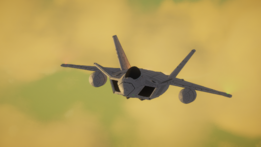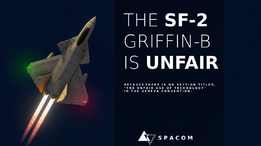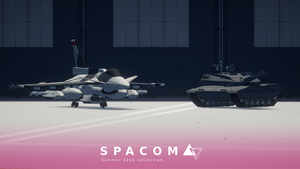SPACOM: Difference between revisions
No edit summary |
(→SF-3) |
||
| Line 33: | Line 33: | ||
In early 2184 the air force tactical operations command demanded that a new aircraft be made to fill the niche of the Z-90L, while also succeeding where the SF-1 program failed. This [[Tactical Air Defence and Strike Aircraft]] ('''TADSA''') as it became known was immidately contracted to SPACOM, with the end result being the '''SF-2 Griffin''' multirole fighter. The Griffin was essentially a stealth makeover of the old Crusader, carrying more payload and having a higher top speed. What was ditched however was the iconic 30 mm rotary cannon of the original, since that was deemed unnecessary in its intended role The first airframe flew in 2186, and the first model entered service in 2187. Two models have been made, the SF-2A had minimal production numbers due to a key error that was found when it was first put into service. The SF-2B was quickly made as a comprehensive improvement of the A-model, with advancements in avionics and radar systems, as well as a heavier focus on ground strike capabilities. The B-model has been in active service since 2188. A proposal was made for a C-model which would focus on improved electronic warfare capabilities but as of 2200 no further developments on this have been made. |
In early 2184 the air force tactical operations command demanded that a new aircraft be made to fill the niche of the Z-90L, while also succeeding where the SF-1 program failed. This [[Tactical Air Defence and Strike Aircraft]] ('''TADSA''') as it became known was immidately contracted to SPACOM, with the end result being the '''SF-2 Griffin''' multirole fighter. The Griffin was essentially a stealth makeover of the old Crusader, carrying more payload and having a higher top speed. What was ditched however was the iconic 30 mm rotary cannon of the original, since that was deemed unnecessary in its intended role The first airframe flew in 2186, and the first model entered service in 2187. Two models have been made, the SF-2A had minimal production numbers due to a key error that was found when it was first put into service. The SF-2B was quickly made as a comprehensive improvement of the A-model, with advancements in avionics and radar systems, as well as a heavier focus on ground strike capabilities. The B-model has been in active service since 2188. A proposal was made for a C-model which would focus on improved electronic warfare capabilities but as of 2200 no further developments on this have been made. |
||
| − | ==== SF-3 ==== |
+ | ==== SF-3 (A, B and C) ==== |
Due to rising tensions at the very end of the 22nd century acting president Montano deemed it necessary to increase military spending and invest in force-multiplying-technologies. All branches of the armed forces started major changes. The air force was urged to restructure and update some antiquated systems, a key focus being air superiority. The Z-80EL was deemed to not have a big enough edge over near peer adversaries as was thought, so talks were made to start yet another advanced fighter program to start phasing out the now nearly century old Fox. A focus was also made on growing less dependent on foreign technologies. Thus another advanced fighter program was started, aimed to develop a true 6th generation aircraft. In an act that now is seen as visionairy, SPACOM was absolved of their guaranteed contract and made to compete with other manufacturers for the first time in 20 years. The [[Next Generation Universal Airframe Program]] ('''NGUAP''') was started in 2198, with the goal of creating a universal fighter aircraft family capable of air superiority, strike/bombing, naval and electronic warfare abilities while being classified as a 6th generation airframe. All variants were not required to be strictly identical, but all are urged to use common parts to streamline and lower maintenance costs. To get awarded the full contract it was mandatory to design airframes for a naval multirole fighter, air superiority fighter and strategic light bomber which all share common parts. Individual designs, if exemplary, could be considered and with cooperation could be conglomerated into universal ones. |
Due to rising tensions at the very end of the 22nd century acting president Montano deemed it necessary to increase military spending and invest in force-multiplying-technologies. All branches of the armed forces started major changes. The air force was urged to restructure and update some antiquated systems, a key focus being air superiority. The Z-80EL was deemed to not have a big enough edge over near peer adversaries as was thought, so talks were made to start yet another advanced fighter program to start phasing out the now nearly century old Fox. A focus was also made on growing less dependent on foreign technologies. Thus another advanced fighter program was started, aimed to develop a true 6th generation aircraft. In an act that now is seen as visionairy, SPACOM was absolved of their guaranteed contract and made to compete with other manufacturers for the first time in 20 years. The [[Next Generation Universal Airframe Program]] ('''NGUAP''') was started in 2198, with the goal of creating a universal fighter aircraft family capable of air superiority, strike/bombing, naval and electronic warfare abilities while being classified as a 6th generation airframe. All variants were not required to be strictly identical, but all are urged to use common parts to streamline and lower maintenance costs. To get awarded the full contract it was mandatory to design airframes for a naval multirole fighter, air superiority fighter and strategic light bomber which all share common parts. Individual designs, if exemplary, could be considered and with cooperation could be conglomerated into universal ones. |
||
Revision as of 21:28, 9 July 2024
|
SPACOM corporation
Security and Precision Aerospace Systems Conglomerate
|
|||||
|---|---|---|---|---|---|
| Industry | Aerospace, Arms, Defence, Information Security | ||||
| Location | |||||
| Headquaters | New Forsetia | ||||
| Area Served | Larrea | ||||
| Founded | 2161 | ||||
| Dissolved | - | ||||
| CEO | - | ||||
| Subsidiaries | (car company) | ||||
SPACOM (Security and Precision Aerospace Systems Conglomerate) is a Larrean Aerospace and Defense manufacturer, being the primary contractor of the Larrean Armed Forces, headquartered in the capital New Forsetia. It was the largest defense contractor in the Baskay region by fiscal revenue in 2198. The company was created in 2161, in the city of Dresa after a merger of local automotive companies. The corporation started gaining serious traction during the civil war, when their manufacturing facilities formerly used for building cars got used to repair, refurbish and upgrade military aircraft by factions controlling Dresa. After the civil war SPACOM started heavily persuing formal military contracts using their newfound experience, and have become an integral part of the Larrean Military Industrial Complex.
Products & History
Z-series aircraft
Z-80EL
SPACOM got most of its starting experience in the aerospace industry during the Forsetti civil war. Many foreign nations and formerly sovereign territories within the peninsula fielded their existing fighters during the conflict. SPACOM, having their largest facility in the heavily fought over city of Dresa, used their automotive plant as a staging ground for repairing and rearming fighter aircraft during the war. Unionist, Caliphate, Private and Communist forces all at one point had control of the city, all making use of the facility. It was within that factory that the first unofficial domestic aircraft models were made, as simple modifications of captured foreign fighters. After the war, the Larrean Air Force together with SPACOM formally requested Cyten-Ward to develop a modified Z-80E Fox that had the same characteristics of the civil war models. Thus the Z-80EL was developed in 2180, license built by SPACOM. Old SL-18 and Z-80 models left over from the war were rebuilt and modified into Z-80EL's, leaving the Larrean Air Force with a formidable arsenal.
Z-90L
The Z-90L, a modification of the Z-90-II Crusader, has a similar story. After the war Cyten-Ward made the export model for the Larrean Air Force and later gave the license to SPACOM. The Z-90L was more extensively modified than the Z-80E to fit the air force's doctrine, as well as to upgrade it to modern specifications.
SF-series aircraft
SF-1 (A)
The SF-series of aircraft were the first fully domestic fighters, designed and built entirely within the republic. The SF-1 Ghost air superiority fighter was the first to have been made, as a result of the air force's Advanced Domestic Fighter Aircraft Program (ADFAP) during spring 2180. ADFAP's main goal was to pioneer advanced avionics, materials and manufacturing techniques for future aircraft while also serving as a symbolic gesture of Larrea's burgeoning independent military. SPACOM's expertise in cost-effective design and manufacturing secured them the contract, even though their design bid performed suboptimal compared to other proposals that were tested. The SF-1 was what became the production model, bearing a surface level appearance to certain foreign stealth fighter designs. Due to rapid technological development, budget cuts, delays and internal politics, it was decided that the SF-1 program (having only had 2 models produced, them being the prototype and the only production model SF-1A) would be cancelled in favour of older cheaper aircraft and future replacements at the end of 2183. Under mysterious circumstances, SPACOM were yet again chosen as the manufacturer for the next models even though no competitive program was set up. Due to the mysterious canning of the SF-1, many believe SPACOM were trying to blackmail the air force into signing a more lucrative deal which would guarantee them being the chosen contractors for future aircraft. The SF-1 has become a pop culture icon among the populace, being seen as a symbol of government corruption.
SF-2 (A and B)
In early 2184 the air force tactical operations command demanded that a new aircraft be made to fill the niche of the Z-90L, while also succeeding where the SF-1 program failed. This Tactical Air Defence and Strike Aircraft (TADSA) as it became known was immidately contracted to SPACOM, with the end result being the SF-2 Griffin multirole fighter. The Griffin was essentially a stealth makeover of the old Crusader, carrying more payload and having a higher top speed. What was ditched however was the iconic 30 mm rotary cannon of the original, since that was deemed unnecessary in its intended role The first airframe flew in 2186, and the first model entered service in 2187. Two models have been made, the SF-2A had minimal production numbers due to a key error that was found when it was first put into service. The SF-2B was quickly made as a comprehensive improvement of the A-model, with advancements in avionics and radar systems, as well as a heavier focus on ground strike capabilities. The B-model has been in active service since 2188. A proposal was made for a C-model which would focus on improved electronic warfare capabilities but as of 2200 no further developments on this have been made.
SF-3 (A, B and C)
Due to rising tensions at the very end of the 22nd century acting president Montano deemed it necessary to increase military spending and invest in force-multiplying-technologies. All branches of the armed forces started major changes. The air force was urged to restructure and update some antiquated systems, a key focus being air superiority. The Z-80EL was deemed to not have a big enough edge over near peer adversaries as was thought, so talks were made to start yet another advanced fighter program to start phasing out the now nearly century old Fox. A focus was also made on growing less dependent on foreign technologies. Thus another advanced fighter program was started, aimed to develop a true 6th generation aircraft. In an act that now is seen as visionairy, SPACOM was absolved of their guaranteed contract and made to compete with other manufacturers for the first time in 20 years. The Next Generation Universal Airframe Program (NGUAP) was started in 2198, with the goal of creating a universal fighter aircraft family capable of air superiority, strike/bombing, naval and electronic warfare abilities while being classified as a 6th generation airframe. All variants were not required to be strictly identical, but all are urged to use common parts to streamline and lower maintenance costs. To get awarded the full contract it was mandatory to design airframes for a naval multirole fighter, air superiority fighter and strategic light bomber which all share common parts. Individual designs, if exemplary, could be considered and with cooperation could be conglomerated into universal ones.
SPACOM provided their bid, the XFAB. A radical departure from earlier designs, it performed exemplary in the areas of air superiority and naval operations without major changes to the airframe. In terms of bombing capabilities, further modifications would be needed such as a higher flight ceiling and increased range. SPACOM managed to win the contract, edging out other competitors without foul play or politics. The designation of SF-3 XXXXXX was given. The variants pertaining to each function are the SF-3A, SF-3C and SF-3B.
Armoured Vehicles
UBT-1 invictus MBT, SPA-1, HIFV, IFV, Stryker lookin ass IFV


